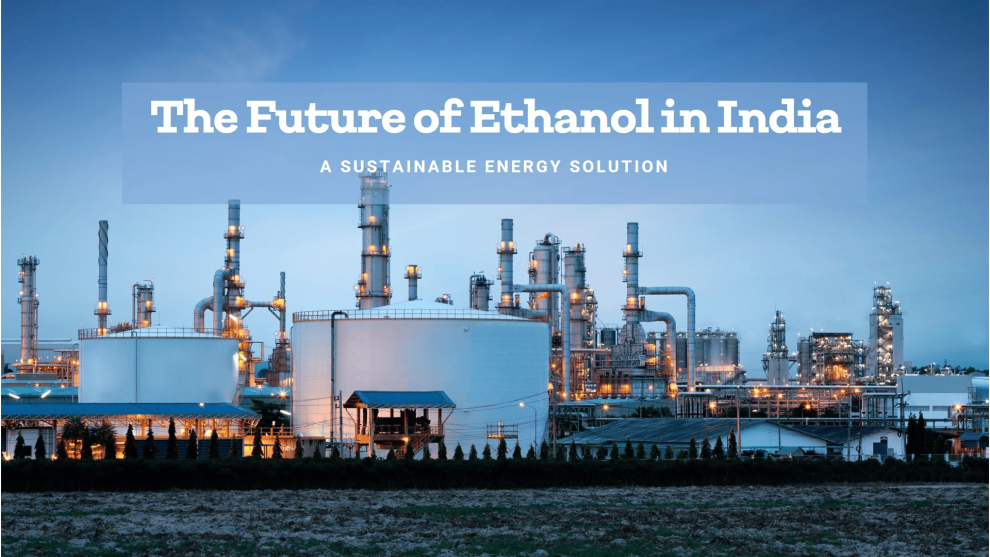As the world increasingly seeks renewable energy solutions to combat climate change and reduce dependence on fossil fuels, India is positioning itself at the forefront of this transformation. Among various renewable energy options, ethanol has emerged as a vital component of India’s energy strategy. With ambitious blending targets and a commitment to sustainable agricultural practices, the future of ethanol in India’s energy mix looks promising. This article explores the pivotal role of ethanol in achieving India’s renewable energy goals, the prospects of reaching the 20% blending target, advancements in second-generation (2G) ethanol production, and potential innovations in biofuel technology.
Ethanol’s Role in India’s Renewable Energy Goals
1. Reducing Greenhouse Gas Emissions
- Ethanol serves as a cleaner alternative to fossil fuels, significantly reducing greenhouse gas emissions when blended with petrol. The combustion of ethanol produces fewer harmful pollutants, contributing to improved air quality and reduced environmental impact.
- By increasing the use of ethanol, India aims to lower its carbon footprint and meet international climate commitments, positioning itself as a responsible global player in the fight against climate change.
2. Enhancing Energy Security
- India is one of the largest consumers of energy globally, heavily reliant on imported crude oil. The integration of ethanol into the fuel mix helps mitigate this dependency, bolstering the country’s energy security.
- Ethanol production from locally sourced feedstock reduces the vulnerability of India’s economy to fluctuations in global oil prices, promoting energy independence and stability.
3. Supporting Rural Economies
- The promotion of ethanol production offers significant economic benefits to rural communities. By providing farmers with a stable market for their crops, ethanol production enhances agricultural incomes and supports livelihoods in rural areas.
- The integration of ethanol production into the agricultural sector can create job opportunities and stimulate local economies, aligning with the government’s focus on rural development.
Prospects of Reaching the 20% Blending Target
1. Current Blending Targets
- The Indian government has set ambitious ethanol blending targets, aiming for a 20% blending of ethanol in petrol by 2025 (E20). This target is a substantial increase from the current 10% (E10) blending level achieved in recent years.
- The 20% blending target is a critical step in achieving India’s renewable energy goals and reflects the government’s commitment to transitioning to a more sustainable energy future.
2. Implementation Strategies
- Achieving the E20 blending target requires a multi-faceted approach that includes expanding production capacity, improving infrastructure, and ensuring a consistent supply of feedstock. Collaboration among government agencies, private sector stakeholders, and farmers will be essential to meet these targets.
- Increased investment in ethanol production facilities, transportation logistics, and storage capacities will play a vital role in supporting the ambitious blending goals.
3. Monitoring Progress
- Regular monitoring and assessment of progress toward blending targets are crucial. The government must implement robust data collection mechanisms to track ethanol production, consumption rates, and the impact of blending on emissions reduction.
- Public awareness campaigns can also educate consumers about the benefits of using ethanol-blended fuel, driving demand and supporting the transition to cleaner energy.
Advancements in Second-Generation (2G) Ethanol
1. Understanding Second-Generation Ethanol
- Second-generation (2G) ethanol is produced from non-food biomass, such as agricultural residues, forestry waste, and dedicated energy crops. This production method addresses concerns related to food vs. fuel competition and utilizes waste materials that would otherwise go unused.
- The adoption of 2G ethanol can significantly enhance the sustainability of ethanol production and expand the feedstock base, offering a viable solution to resource constraints.
2. Technological Innovations
- Recent advancements in biotechnology and fermentation processes have made 2G ethanol production more efficient and cost-effective. Innovations such as enzyme technology, gasification, and advanced fermentation methods are enabling higher yields from biomass feedstocks.
- Collaborative efforts among research institutions, universities, and industry players are essential for further developing and commercializing 2G ethanol technologies, ensuring their scalability and sustainability.
3. Policy Support for 2G Ethanol
- The Indian government has recognized the potential of 2G ethanol and is actively promoting its development through supportive policies and funding initiatives. Grants for research and development, tax incentives for production facilities, and infrastructure support can accelerate the adoption of 2G ethanol.
- By creating a conducive environment for innovation, India can position itself as a leader in the global biofuels market, attracting investments and fostering sustainable growth.
Potential Innovations in Biofuel Technology
1. Advancements in Biofuel Production
- The future of ethanol and biofuels lies in continuous innovation and technological advancements. Research into new feedstocks, such as algae and waste oils, has the potential to expand the feedstock base and enhance production efficiency.
- Innovations in production processes, including integrated biorefineries that produce multiple products from the same biomass feedstock, can further enhance the economic viability of ethanol production.
2. Integrating Renewable Energy Sources
- Combining ethanol production with other renewable energy sources, such as solar and wind, can lead to greater energy efficiency and lower production costs. Integrating renewable energy into the ethanol production process can minimize dependence on fossil fuels and reduce greenhouse gas emissions.
- The use of renewable energy in distillation processes and facility operations can create a more sustainable and environmentally friendly ethanol production model.
3. Collaboration and Knowledge Sharing
- The development of innovative biofuel technologies requires collaboration across various sectors, including academia, industry, and government. Knowledge sharing and partnerships can accelerate research and development efforts, bringing cutting-edge solutions to market more rapidly.
- Public-private partnerships can play a vital role in driving innovation and ensuring that the ethanol industry evolves to meet future energy demands.
Conclusion
The future of ethanol in India’s energy mix holds tremendous promise as the nation works toward achieving its renewable energy goals. With ambitious blending targets, a focus on second-generation ethanol production, and a commitment to technological innovation, India is poised to become a leader in the global biofuels market.
Ethanol not only offers a sustainable solution for reducing greenhouse gas emissions but also supports rural economies and enhances energy security. By addressing challenges such as feedstock availability, infrastructure constraints, and investment gaps, India can unlock the full potential of its ethanol industry.
As the country navigates this transition toward a cleaner energy future, collaboration among stakeholders, ongoing research and development, and policy support will be critical. With a clear vision and concerted efforts, India can pave the way for a sustainable energy landscape, leveraging ethanol as a cornerstone of its renewable energy strategy.












Add Comment